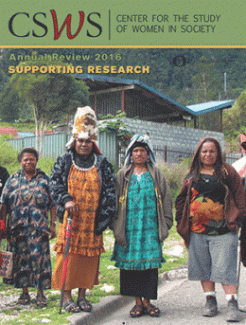Contents:
- “CSWS Has a New Director,” by Alice Evans, Managing Editor
Faculty Research:
- “Voices of the Vanquished,” by Gina Herrmann, Associate Professor of Spanish, Romance Languages
- “The Afterlife of Princess Ka‘iulani,” by Stephanie Teves, Assistant Professor, Ethnic Studies and Women’s and Gender Studies
- “Women in Papua New Guinea,” by Aletta Biersack, Professor, Department of Anthropology
- “Daughters of the Moon: True Life Stories from the Lacandon Rain Forest,” by Analisa Taylor, Associate Professor of Spanish, Department of Romance Languages
- “The Forgotten Story of Japanese Women Who Studied in the U.S.,” by Alisa Freedman, Associate Professor, Japanese Literature and Film
- “HandiLand: Nature, Disabililty and the Magic Kingdom,” by Elizabeth A. Wheeler, Associate Professor, Department of English
Graduate Student Research:
- “Raising Chickens: Women and the Emergence of Poultry Production,” by Elizabeth C. Miller, ABD, Department of Sociology
- “Melodramatics of Turkish Modernity,” by Baran Germen, PhD candidate, Department of Comparative Literature
- ”Gender, Inclusion, and Military Recruiting,”by Jeremiah Favara, PhD candidate, School of Journalism and Communication
- “Deportation & Redefining Masculinities on the Northern Mexico Border,” by Tobin Hansen, PhD candidate, Department of Anthropology
- “This Body Could Be Mine,” by Danielle Seid, PhD candidate, Department of English
Highlights from the Academic Year:
- Looking at Books
- NWWS: Crossing Borders
- “Putting a Face to Child Immigrants,” by Lidiana Soto, master’s candidate, School of Journalism and Communication
- “Remembering Joan Acker”
Publication Year
2016
Articles
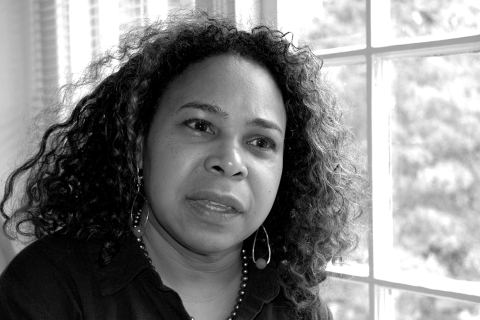
CSWS Has a New Director: An Interview with Michelle McKinley
When Michelle McKinley applied for the position of CSWS director earlier this year, an academic colleague exclaimed in ironic surprise: “But you hate administration!” It seems a fair question, then, to ask Dr. McKinley—law school professor, human rights lawyer, cultural anthropologist, mother of four children, caretaker of her own father, and an obviously busy and committed human being—why she took on the administration of an academic research center.

Voices of the Vanquished: Spanish Women on the Left between Franco and Hitler
by Gina Herrmann, Associate Professor of Spanish, Romance Languages
On April 14, 1945, the very day the Allied troops liberated the Ravensbrück Nazi camp for women, inmate 43225, Mercedes Núñez Targa (1911-1986), had been slated for transport to the camp gas chamber. Núñez Targa’s route to Ravensbrück had begun in 1931 with the declaration of Spain’s progressive Second Republic. Mobilized in youth organizations along with hundreds of thousands of women who supported the Republic, Núñez Targa eventually took up a post as the head of the Spanish Communist Party in her native region of Galicia.
On April 14, 1945, the very day the Allied troops liberated the Ravensbrück Nazi camp for women, inmate 43225, Mercedes Núñez Targa (1911-1986), had been slated for transport to the camp gas chamber. Núñez Targa’s route to Ravensbrück had begun in 1931 with the declaration of Spain’s progressive Second Republic. Mobilized in youth organizations along with hundreds of thousands of women who supported the Republic, Núñez Targa eventually took up a post as the head of the Spanish Communist Party in her native region of Galicia.
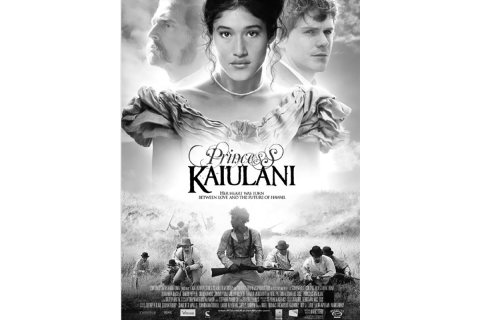
The Afterlife of Princess Ka‘iulani
by Stephanie Teves, Assistant Professor, Departments of Ethnic Studies and Women’s and Gender Studies
Acting as a subtle form of resistance to settler colonialism, a film and play about a Hawaiian Kingdom princess who died more than a hundred years ago allows Native Hawaiians to honor Ka‘iulani by thinking about her life and that of the Kingdom critically.
Acting as a subtle form of resistance to settler colonialism, a film and play about a Hawaiian Kingdom princess who died more than a hundred years ago allows Native Hawaiians to honor Ka‘iulani by thinking about her life and that of the Kingdom critically.
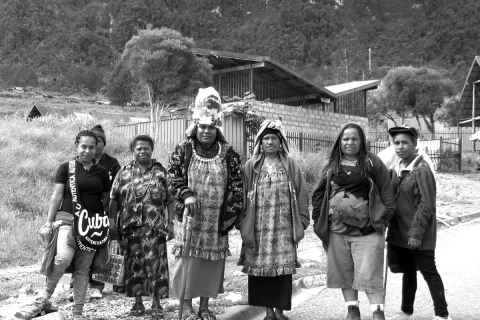
Women in Papua New Guinea: Gendered Transformations in the Ipili Mining Era
by Aletta Biersack, Professor, Department of Anthropology
Between late March and the end of July 2015, I resumed my research on gender in the Porgera and Paiela valleys of Enga Province, Papua New Guinea (PNG). PNG achieved independence from Australia in 1975. Gold has been mined in the Porgera valley since the mid-1940s, but it was not until 1990, when hard rock mining operations replaced alluvial mining, that these two valleys underwent rapid change. I went to PNG to see for myself what had changed. I was especially interested in impacts on women.
Between late March and the end of July 2015, I resumed my research on gender in the Porgera and Paiela valleys of Enga Province, Papua New Guinea (PNG). PNG achieved independence from Australia in 1975. Gold has been mined in the Porgera valley since the mid-1940s, but it was not until 1990, when hard rock mining operations replaced alluvial mining, that these two valleys underwent rapid change. I went to PNG to see for myself what had changed. I was especially interested in impacts on women.
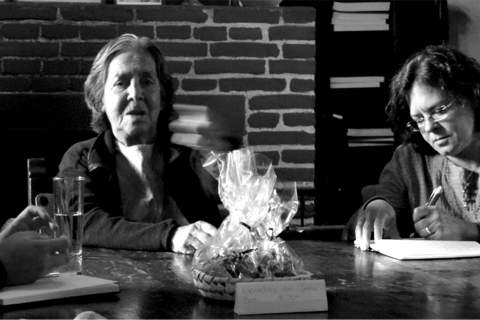
Daughters of the Moon: True Life Stories from the Lacandon Rain Forest
by Analisa Taylor, Associate Professor of Spanish, Department of Romance Languages
In Entre anhelos y recuerdos, the late Marie-Odile Marion interweaves the vivid and wistful life stories told to her by six Lacandon Maya women, representing three generations, with her own anguished reflections on her ethical responsibility toward them as their welfare became increasingly fragile toward the close of the twentieth century. Their stories reflect an erosion of the centuries-old kinship networks and symbolic order that had previously shaped Lacandon Mayan women’s identities and livelihoods throughout each stage of their lives.
In Entre anhelos y recuerdos, the late Marie-Odile Marion interweaves the vivid and wistful life stories told to her by six Lacandon Maya women, representing three generations, with her own anguished reflections on her ethical responsibility toward them as their welfare became increasingly fragile toward the close of the twentieth century. Their stories reflect an erosion of the centuries-old kinship networks and symbolic order that had previously shaped Lacandon Mayan women’s identities and livelihoods throughout each stage of their lives.

The Forgotten Story of Japanese Women Who Studied in the United States, 1949-1966
by Alisa Freedman, Associate Professor, Japanese Literature and Film, Department of East Asian Languages and Literatures
Between 1949 and 1966, at least 4,713 Japanese students studied at American universities with the best-known fellowships at the time—GARIOA (Government Account for Relief in Occupied Areas [1949 through 1951]) and Fulbright (established in 1952)—along with a few private scholarships. This group included 651 women. Among them were future leaders in fields as diverse as literature, medicine, economics, athletics, and political science.
Between 1949 and 1966, at least 4,713 Japanese students studied at American universities with the best-known fellowships at the time—GARIOA (Government Account for Relief in Occupied Areas [1949 through 1951]) and Fulbright (established in 1952)—along with a few private scholarships. This group included 651 women. Among them were future leaders in fields as diverse as literature, medicine, economics, athletics, and political science.
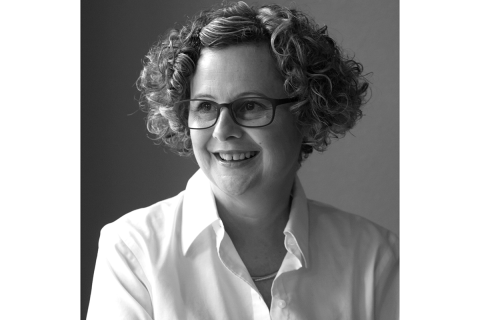
HandiLand: Nature, Disabililty and the Magic Kingdom
by Elizabeth A. Wheeler, Associate Professor, Department of English
My fall 2015 CSWS Faculty Research Grant proved crucial to the development of my book, HandiLand: The Crippest Place on Earth. HandiLand explores representations of disability in young adult and children’s literature since 1990. In recent decades, new rights laws worldwide have allowed young people with disabilities to infiltrate many spheres of public space. Literature for young readers reflects this new public presence—and also maps how far we still need to go to achieve equality.
My fall 2015 CSWS Faculty Research Grant proved crucial to the development of my book, HandiLand: The Crippest Place on Earth. HandiLand explores representations of disability in young adult and children’s literature since 1990. In recent decades, new rights laws worldwide have allowed young people with disabilities to infiltrate many spheres of public space. Literature for young readers reflects this new public presence—and also maps how far we still need to go to achieve equality.
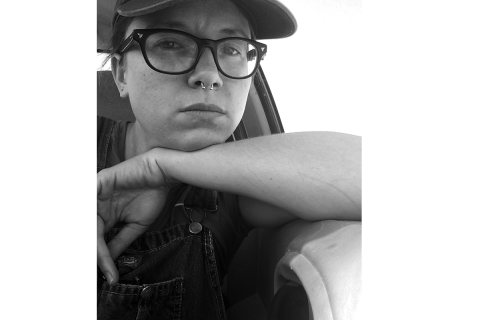
Raising Chickens: Women and the Emergence of Poultry Production
by Elizabeth C. Miller, ABD, Department of Sociology
Prior to receiving the CSWS Graduate Student Research Grant I’d spent six months conducting ethnographic fieldwork on two large-scale, industrialized chicken farms. This always led to interesting reactions when people asked what I did for a living. Many people expressed disgust, curiosity, surprise, or they just cut to the chase and asked if I was now a vegan. As a social scientist, I am always looking for patterns in people’s behavior, but I found no correlations between people’s responses to my work and their identities. In fact, people’s responses to my project seemed quite random, except for one group of people: backyard chicken keepers.
Prior to receiving the CSWS Graduate Student Research Grant I’d spent six months conducting ethnographic fieldwork on two large-scale, industrialized chicken farms. This always led to interesting reactions when people asked what I did for a living. Many people expressed disgust, curiosity, surprise, or they just cut to the chase and asked if I was now a vegan. As a social scientist, I am always looking for patterns in people’s behavior, but I found no correlations between people’s responses to my work and their identities. In fact, people’s responses to my project seemed quite random, except for one group of people: backyard chicken keepers.
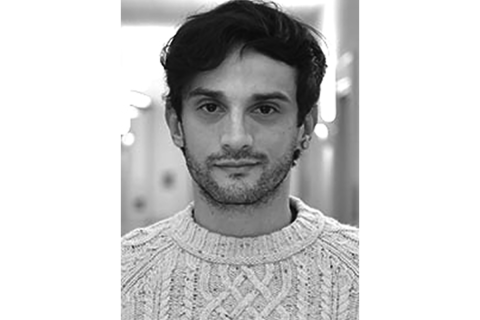
Melodramatics of Turkish Modernity: Narratives of Victimhood, Affect, and Politics
by Baran Germen, PhD candidate, Department of Comparative Literature
In 2013, at the height of the Gezi Park protests, several national media outlets reported a shocking case of public harassment in Kabataş, a central neighborhood of Istanbul. The alleged account that approximately a hundred shirtless male protestors attacked a veiled woman with a six-month-old baby was immediately taken up by the then Turkish Prime Minister Recep Tayyip Erdoğan. “They attacked my veiled sister,” said the injured Erdoğan repeatedly in a brotherly alliance with the victim of the so-called Kabataş attack.
In 2013, at the height of the Gezi Park protests, several national media outlets reported a shocking case of public harassment in Kabataş, a central neighborhood of Istanbul. The alleged account that approximately a hundred shirtless male protestors attacked a veiled woman with a six-month-old baby was immediately taken up by the then Turkish Prime Minister Recep Tayyip Erdoğan. “They attacked my veiled sister,” said the injured Erdoğan repeatedly in a brotherly alliance with the victim of the so-called Kabataş attack.

Gender, Inclusion, and Military Recruiting: An Exploration of 40 Years of Marketing the Military to Women
by Jeremiah Favara, PhD candidate, School of Journalism and Communication
On December 3, 2015, Secretary of State Ashton B. Carter announced that all combat positions in the U.S. military would be opened to women. Less than two months after the announcement, I received a recruiting flyer in the mail from the Oregon Army National Guard featuring a photo of a woman soldier in camouflage fatigues and touting new opportunities in combat occupations for women. While the opening of all combat positions to women is unprecedented, the publication of recruiting materials featuring images of women soldiers and appeals based on new opportunities for women has been crucial to military recruiting efforts for the last forty years.
On December 3, 2015, Secretary of State Ashton B. Carter announced that all combat positions in the U.S. military would be opened to women. Less than two months after the announcement, I received a recruiting flyer in the mail from the Oregon Army National Guard featuring a photo of a woman soldier in camouflage fatigues and touting new opportunities in combat occupations for women. While the opening of all combat positions to women is unprecedented, the publication of recruiting materials featuring images of women soldiers and appeals based on new opportunities for women has been crucial to military recruiting efforts for the last forty years.
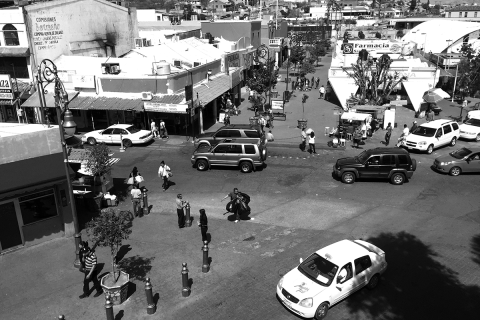
Deportation and Redefining Masculinities on the Northern Mexico Border
by Tobin Hansen, PhD candidate, Department of Anthropology
“It’s like being dropped off on the other side of the world... Here, I’m nobody. I’m nothing,” Carlos murmurs, searching for words to describe deportation to Nogales, Sonora, Mexico after living in the United States for thirty years, since age four. We lean against an abandoned cement house on a narrow street for one of many conversations. Carlos’s faded black and red flannel envelops arm and neck tattoos in Old English script: Phoenix street gang, list of years incarcerated, “Forever Blessed.”
“It’s like being dropped off on the other side of the world... Here, I’m nobody. I’m nothing,” Carlos murmurs, searching for words to describe deportation to Nogales, Sonora, Mexico after living in the United States for thirty years, since age four. We lean against an abandoned cement house on a narrow street for one of many conversations. Carlos’s faded black and red flannel envelops arm and neck tattoos in Old English script: Phoenix street gang, list of years incarcerated, “Forever Blessed.”
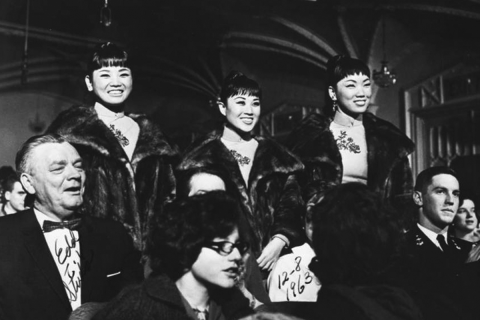
This Body Could Be Mine: Representations of Asian American Women on American Network Television
by Danielle Seid, PhD candidate, Department of English
Over winter break, I had a chance to speak with lifelong entertainer Sue Kim, one of three sisters in the musical girl group the Kim Sisters. A few years after the Korean War, in 1959, the group—Sue, Mia, and Ai-Ja— arrived in the United States as “cultural ambassadors” from the Republic of Korea. They were immediately booked on the highest-rated television variety shows at the time, most prominently The Ed Sullivan Show (1948-1971).
Over winter break, I had a chance to speak with lifelong entertainer Sue Kim, one of three sisters in the musical girl group the Kim Sisters. A few years after the Korean War, in 1959, the group—Sue, Mia, and Ai-Ja— arrived in the United States as “cultural ambassadors” from the Republic of Korea. They were immediately booked on the highest-rated television variety shows at the time, most prominently The Ed Sullivan Show (1948-1971).
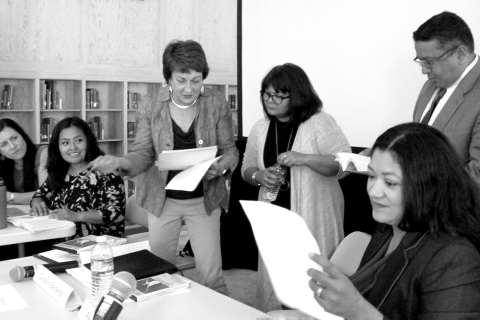
NWWS: Putting a Face to Child Immigrants
by Lidiana Soto, master’s candidate, UO School of Journalism and Communication
Everything about how we physically crossed the border is like snapshots. Small vignettes and blurry, patchy, unreliable memories. We left the village in southern Oaxaca under a waning gibbous moon. My mother woke me in the middle of the night, wrapped me up in a blanket, and carried me onto the bus. I called the driver manejador and my mother chuckled and corrected me; chófer she said as she held on to my six-month-old brother. I settled onto the bench seat and watched the moon light the dark landscape as we drove away from Santa Maria Tindu.
Everything about how we physically crossed the border is like snapshots. Small vignettes and blurry, patchy, unreliable memories. We left the village in southern Oaxaca under a waning gibbous moon. My mother woke me in the middle of the night, wrapped me up in a blanket, and carried me onto the bus. I called the driver manejador and my mother chuckled and corrected me; chófer she said as she held on to my six-month-old brother. I settled onto the bench seat and watched the moon light the dark landscape as we drove away from Santa Maria Tindu.


